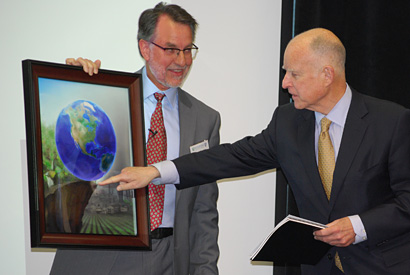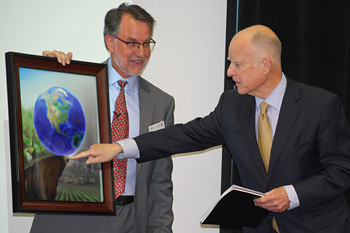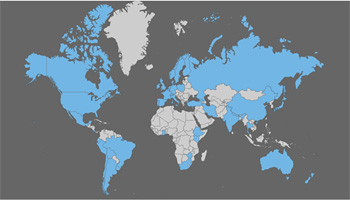World’s top scientists: California & nations must act now on environment
At the request of California Gov. Jerry Brown, UC Berkeley biologist Tony Barnosky prepared with 15 other scientists a consensus statement about the environmental problems endangering Earth and what policy makers should do about it, and garnered more than 500 signatures before presenting it to Brown on May 23.

May 23, 2013
Responding to a challenge by California Gov. Jerry Brown, more than 500 of the world’s top global change scientists have outlined the main environmental issues – from climate change to pollution and population growth – that policy makers must address immediately to avoid an approaching global tipping point.

Gov. Jerry Brown discussing Earth’s tipping point with UC Berkeley professor Tony Barnosky at the WEST Summit 2013. Barnosky led an effort to provide Brown and other world leaders with a playbook on how to address global environmental problems such as climate change. Courtesy Rob Jordan/Stanford Woods Institute for the Environment.
The leaders of the initiative joined Gov. Brown on May 23 and gave him a copy of the 30-page statement, “Maintaining Humanity’s Life Support Systems in the 21st Century,” at the 2013 Water, Energy and Smart Technology Summit and Showcase, an event designed to mobilize Silicon Valley innovation to tackle planet-wide problems.
Held at NASA Ames Research Center in Mountain View, Calif., the joint venture by NASA Ames and the non-profit group Sustainable Silicon Valley is being sponsored, in part, by a who’s who list of top Silicon Valley companies.
“Governor Brown asked me last year why, if global change is such a big deal, scientists are just publishing in scientific journals and not translating their findings into terms that policy makers, industry and the general public can understand and start to address,” said Anthony Barnosky, UC Berkeley professor of integrative biology. Barnosky was lead author of a scientific paper last year warning that Earth is approaching a tipping point beyond which the planet’s climate and biodiversity will be radically and unalterably changed beyond anything humanity has known.
“Here are 520 scientists from throughout the world making a very strong statement, with as little waffling as possible, about Earth’s environmental problems, and we’re putting it in the hands of policy makers so they can understand and start formulating solutions,” he said. “And we are starting with the governor of California, the world’s ninth largest economy.”
The scientists, representing a variety of expertise on the impact of humans on Earth’s ecosystems, identify five key threats: climate change, which has already led to increasing global temperatures, rising sea levels and dramatic changes in weather patterns; high rates of extinction for both animals and plants; the loss of ecosystems around the planet as they are paved over, plowed or tamed; the pressure from a steadily increasing human population; and pollution.
“We’re in a war here in the contest of ideas. You have to reach people who are skeptical, disinterested and maybe even somewhat hostile,” Brown said after listening to the scientists at the meeting. “It will take some critical mass to first communicate the point and then create the conditions by which we can begin to make change.”
The full text of the statement and a list of the signatories – they hail from 44 countries and include two Nobel laureates, 33 members of the U.S. National Academy of Sciences and members of other nation’s scientific academies – is on the website of the Millennium Alliance for Humanity and the Biosphere, where it is available for signing by other scientists and the general public.
Sounding the alarm
“As members of the scientific community actively involved in assessing the biological and societal impacts of global change, we are sounding this alarm to the world,” the scientists write in the summary. “For humanity’s continued health and prosperity, we all – individuals, businesses, political leaders, religious leaders, scientists and people in every walk of life – must work hard to solve these five global problems, starting today.”
“In 30 years there are a few things that people will credit us for doing now, or bemoan our failure if we don’t. Grappling with climate change, and stopping it, is the best gift we can give the future, because unstopped it will crack our society and impoverish our children,” said Stephen Palumbi, one of the statement’s 16 main authors, a professor of biological sciences at Stanford University and the director of Stanford’s Hopkins Marine Station in Pacific Grove, Calif.

A map of the 44 countries of the 520 scientists who signed the consensus statement about the threat of global environmental change.
The statement does not recommend specific strategies, Barnosky said, but pinpoints the major issues that need to be addressed and feasible broad-brush solutions. For example, to deal with climate change, “it is essential to get off fossil fuels as fast as possible. If we don’t, we are not going to make it. Period,” he said.
“How we mitigate and manage these interacting environmental impacts will determine whether or not human quality of life declines over the next few decades,” Barnosky added. “This is not the first time scientists have alerted decision makers to these issues, but we are doing it now much more forcefully. There is a lot of new and alarming scientific insight about the environmental changes currently taking place and how this is profoundly affecting humanity.”
Communicating science to politicians
“Our report, having been requested by the California governor, might be an important move forward in our effort to communicate science to politicians. I find this to be ‘science for policy’ at its best,” said Nils Chr. Stenseth, another of the statement’s main authors. Stenseth is a professor of ecology and evolution and a member of the Centre for Ecological and Evolutionary Synthesis at the University of Oslo.
Among the recommendations are:
- Reduce the effects of climate change by decreasing greenhouse gas emissions and planning now how to adapt to the consequences already underway. To achieve this, replace fossil fuels with carbon-neutral energy sources, such as solar, wind and biofuels; promote energy-efficient buildings, transportation and manufacturing systems; conserve forests and regulate land conversion to maximize carbon sequestration and ecosystem services; and develop plans to deal with such climatic impacts as sea-level rise and shifting patterns of agricultural productivity.
- Slow the global loss of biodiversity by recognizing both the long-term economic benefits and intangible gains that accrue from protecting natural ecosystems from global pressures, such as ocean acidification, and local pressures, such as overfishing or forest conversion.
- Curb the manufacture and release of toxic substances into the environment with regulations on existing as well as new chemicals, and bolster research to develop safer alternatives.
- Slow land conversion, which has already transformed 40 percent of Earth’s surface into farms and ranches, cities and suburbs. This can be achieved by improving the efficiency of food production in existing agricultural areas and better food distribution while decreasing waste. Encourage urban growth rather than suburban sprawl so as to preserve natural landscapes that enhance such critical human services as water quality.
- Slow and eventually stop world population growth, with a peak of no more than 9 billion, decreasing to less than 7 billion by 2100. To achieve this, ensure access to education, economic opportunities and health care, including family planning services, with a special focus on women’s rights. Promote environmentally friendly changes in consumer behavior.
Also on hand to release the statement to Gov. Brown were Palumbi and statement coauthors Elizabeth Hadly, Anne and Paul Ehrlich and Rodolfo Dirzo, all Stanford professors. Other leaders of the initiative are Rosamond Naylor, Gretchen Daily and Harold A. Mooney of Stanford; Marvalee Wake of UC Berkeley; James Brown of the University of New Mexico; Estella B. Leopold of the University of Washington; Mikael Fortelius and Jussi Eronen of the University of Helsinki, Finland; and John Peterson Myers, founder, CEO and chief scientist of Environmental Health Sciences.
Barnosky was the statement’s lead writer when he was the Cox Visiting Professor in Stanford University’s Department of Environmental Earth Systems Science. He is also a member of the Berkeley Initiative in Global Change Biology (BiGCB), an ambitious effort to analyze biological records during ancient and more recent episodes of environmental change to better forecast how plant and animal populations might adapt to our rapidly changing planet.
RELATED INFORMATION